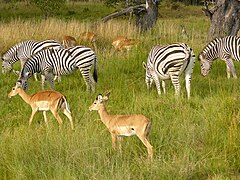Chobe National Park
| Chobe National Park | |
|---|---|
 Wildebeest and zebras in Chobe National Park | |
| Location | Botswana |
| Nearest city | Kasane |
| Coordinates | 18°39′S 24°24′E / 18.650°S 24.400°E |
| Area | 11,700 km2 (4,500 sq mi) |
| Established | 1967 |
Chobe National Park is
This park is noted for having a population of lions which prey on elephants, mostly calves or juveniles, but also subadults.[1]
History
The original inhabitants of this area were the
At the beginning of the 20th century, the region that would become Botswana was divided into different land tenure systems. At that time, a major part of the park's area was classified as crown land. The idea of a national park which would protect the varied local wildlife and promote tourism was first proposed in 1931. The following year, 24,000 km2 (9,300 sq mi) around Chobe district were officially declared a non-hunting area, and this area was expanded to 31,600 km2 (12,200 sq mi) two years later.
In 1943, heavy
At that time there were several industrial settlements in the region, especially at Serondela, where the
Geography and ecosystems

The park can be divided up to 4 areas, each corresponding to one distinct ecosystem:
- The Serondela area (or Chobe riverfront), situated in the extreme Northeast of the park, has as its main geographical features lush floodplains and dense woodland of Victoria Falls, Zambia. The town of Kasane, situated just downstream, is the most important town of the region and serves as the northern entrance to the park.
- The Savuti Marsh area, 10,878 km2 (4,200 sq mi) large, constitutes the western stretch of the park (50 km (31 mi) north of Mababe Gate). The Savuti Marsh is the relic of a large inland lake whose water supply was cut a long time ago by birdlife of 450 species is represented. Prides of lions, hyenas, zebras or more rarely Southeast African cheetahsare sighted as well. This region is reputed for its annual migration of zebras and predators.
- The Linyanti Marsh, located at the northwest corner of the park and to the north of Savuti, is adjacent to the red lechwe, sitatunga and a bask of Nile crocodilesalso occur in the area. Bird diversity is rich.
- Between Linyanti and Savuti Marshes lies a hot and dry hinterland, mainly occupied by the Nogatsaa grass woodland. This section is little known and is a great place for spotting common eland.
Elephant concentration

The park is widely known for its large elephant population, estimated to be around 50,000.[
Roads
Road conditions in Chobe National Park depend greatly on the season and rainfall; one needs a 4x4 vehicle to travel in the Park. Thick sand becomes a problem in the Chobe River Front during the dry months, particularly as the temperature rises, while during the wet season the roads near the river become muddy.[4]
Savuti
Savuti roads, mainly the western Sandridge Road from Mababe Gate and the roads both north and south of the Savuti channel are typically thick sand and tricky to drive. When rain has fallen, driving along the marsh roads carries the risk of getting stuck, as the wet black cotton soil becomes unnavigable.[4]
Nogatsaa
Nogatsaa roads are waterlogged during the wet months and very little of the road network can be driven at this time. During the dry months, game drives from one pan to the next are on roads with small, thick sandy patches. Once leaving the tar road from Kasane, people would have to drive through thick sand for the first 20 km (12 mi), before reaching a sand road.[4]
See also
References
- Wikidata Q54086334.
- ^ "Botswana - History". Britannica. Retrieved 2023-03-19.
- ^ "Elephant culls in Chobe". Archived from the original on 2008-01-11. Retrieved 2006-06-13.
- ^ a b c "Chobe National Park, October 2017". Independent Travellers. independent-travellers.com. Retrieved March 17, 2018.










